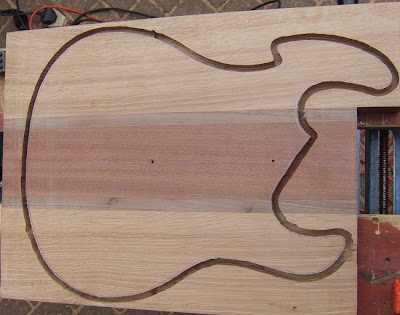 | |||
| Technofret Advanced Fret Levelling System & My String Lifter. |
The idea is simple and an appealing one. The fretboard under tension (allegedly as I don't have information proving this) doesn't bow in a pure curve. With the stings on and the neck under truss rod tension the neck _can_ form a slight S type bend. Using the TAFLS you can level the frets with the board flat under tension which will also (possibly) include any unwanted bows. The truss rod is then released slightly to set the correct relief and you should end up with a better relief curve. Or so it says on the tin, or didn't in this case.
First part of the process is to get the marker pen out and blacken the tops of all the frets. Usually I do this after I have taped up the fretboard but ideally the blocks used n the levelling process need to rest on the wood so you have to do this with the board unprotected. I managed to get two indelible marks on the fretboard. Doh!
With the strings set to normal tuning flatten the fretboard by tensioning the truss-rod. To check straightness you use the three supplied blocks, one at the first fret, one at about the 17th fret and then somewhere in the middle should do. I used a small LED torch to gauge the gap. By slowly adding tension on the truss rod you can get to the point that you have no light between the straight edge and the middle block. By moving the straight edge left to right you can also check at what point it can begin to drag on the middle block. One issue is that the straight edge is about 38mm tall and is balanced on its 5mm width on the two outermost blocks. Moving the truss rod will at some point cause the edge to fall and clatter off onto the fretboard if you are not careful. It complicates the set-up but not much.I did check the tuning after moving the truss rod but in my case it hardly changed.
 |
| Checking relief at middle block. |
Next get the U channel out. It came with two grits of 400 and 600. As I am not in a rush I used only the 600 grit and then used my own tape to place a 1000 grit strip on the other side of the channel. The channel being 1.6mm thick didn't readily fit under the strings at the first fret frets, so I had to lift the strings. The advice from TAFLS is to use a spacer to lift the strings up, checking correct tune. However I had a small L-shaped bit of alloy handy which I cut to run under two strings at a time. With some protective tape underneath I could easily lift two strings a fraction.
 |
| DIY String Lifter |
With the frets marked up I did a gentle pass with the 1000 grit. I had already done a traditional fret dress with a 350mm plane as a flat with the strings off, so I was interested to see if the TAFLS idea held up. As you can see below frets 1-4 are being abraded whilst fret 5 (visible) 6, 7 and 8 have a dip and the black marker is still there. Strat necks are more likely to show this behaviour apparently though I have no real solid information myself. This didn't surprise me as the guitar did fret out on the first few frets if the action was set too low.
 | ||
| Fret five, still black |
I would step across the neck one string at a time from low E to high E doing a small circular motion each time and then turn the U channel round and repeat the process from high E to low E. I would always lift the strings in pairs to make room for the U channel flange. After getting down to all frets showing abrasion I turned the channel over and used the 1000 grit to complete the initial dress.
After completing the dress the fret ends were re filed and the crowns re profiled. The frets were polished to 2500 grit and then a Dremel and some metal polish to finish off.
At the end of the process I can say that the TAFLS worked a treat on this neck. This said, a 7.5inch neck will never be as low as my other guitars with a more forgiving radius I can say that this time it was better than before and the action is now as low as I can hope for allowing bends not to fret out. Possible I didn't flatten the fretboard in my previous attempt but despite feeling it was expensive for what I got, the result made it money well spent.I do worry that the channel doesn't feel robust so I have a separate place to store it. Just for the record, I don't have any association with the source of the TAFLS other than I purchased one for full price. There are other questions I would like answered. How much does adding tension to the truss rod change the neck, should it be a combination of added tension and slightly de-tuning the strings? Where is it best to place the middle block and in the case of large block inlays, is it OK to use fret 8 where there is no inlay? It isn't the only under-fret, under tension method available, but it was local and not too expensive. Maybe it's a fashion that will soon disappear, but I can see the logic of dressing frets with the neck under tension.






























